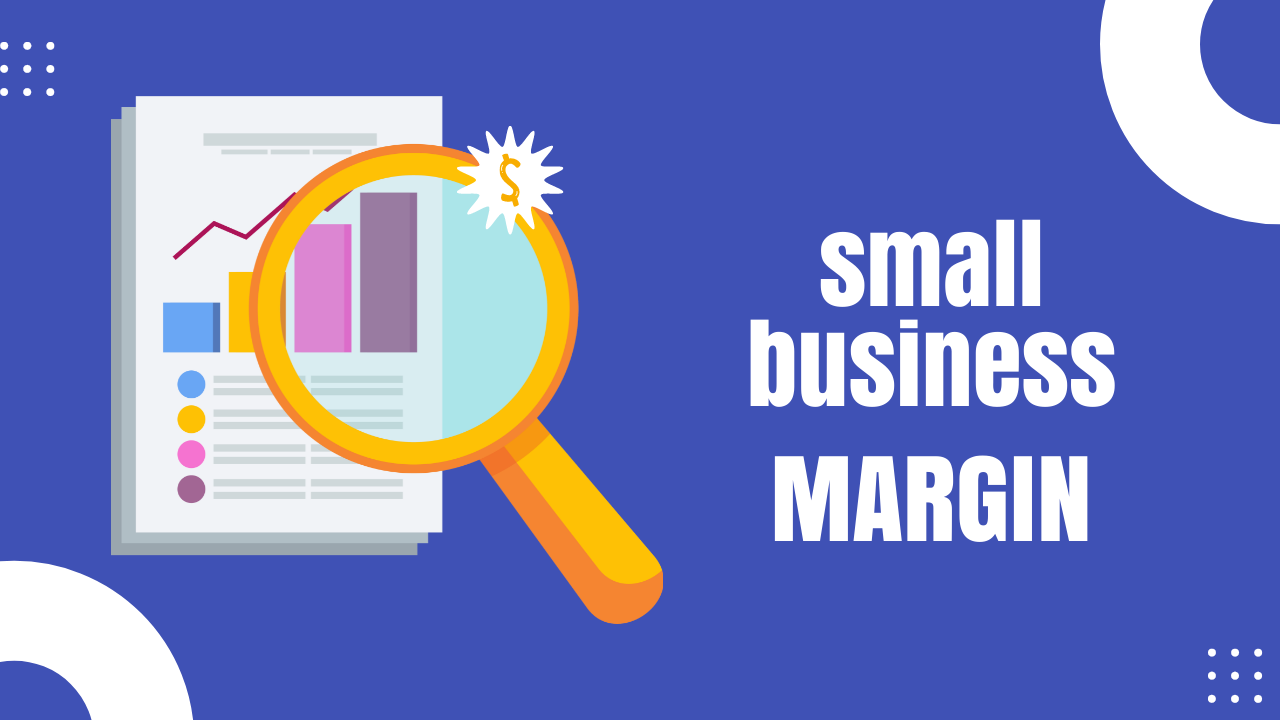What is a Good Profit Margin for a Small Business?
What's a good profit margin for a small business? Delve into industry-specific profit margins and optimize your business's profitability.

Setting prices and managing finances are critical tasks for any small business owner striving for sustainable growth.
One key aspect of financial management is understanding your profit margin – the amount by which your sales revenue exceeds your production costs.
But what constitutes a good profit margin for a small business?
The Profitability Guide: What is a Reasonable Profit Margin for a Small Business?
The answer isn’t always straightforward, as it depends on factors such as industry norms, company size, and market competition.
In this article, we will explore the ins and outs of profit margins for small businesses and provide guidance on how to determine a suitable margin for your venture.

Why Knowing Your Margins Matters
⭐ Reason #1: Informed Pricing Decisions 📈
Profit margins guide your pricing strategy, helping you strike the perfect balance between competition and profitability. By diving deep into costs and pinpointing areas for efficiency, small business owners can strike a balance that optimizes earnings.
⭐ Reason #2: Progress Tracking 📊
Monitoring profit margins over time allows you to gauge your business's overall health and sustainability. You can facilitate increased returns by tracking this key performance indicator (KPI).
⭐ Reason #3: Fostering Growth 💰
Aiming for an optimal profit margin lets you strategically reinvest earnings into your business. By calculating the ideal range, you'll determine the sales volume required to cover expenses and enjoy a positive net margin, paving the way for expansion and success.
⭐ Reason #4: Providing Business Longevity 🌱
Be it a service or product-oriented venture, it's fundamental to understand the cost to generate every additional revenue dollar. By knowing your cost structure and revenue generation, you'll confidently navigate the ups and downs of entrepreneurship and build a resilient organization.
What Are Profit Margins?
At their core, profit margins show you how much your business makes compared to its spending. It's like the magic number that tells you if your business is a cash cow or a dud. 🐮💔
There are 3 types of profit margins:
- gross
- net
- operating.
Gross profit margin gives you the scoop on how much money you have left after paying for everything you sell.
Net profit margin takes it up by factoring in all the expenses, giving you the real deal on how much your business is actually making.
The operating profit margin sits pretty in the middle, considering all the business costs, except for interest and taxes. It provides insight into the business's inner mechanics and offers clarity to the broader picture.
Profit margins are like a superpower that helps you evaluate your business's financial fitness and how well it's running. Knowing them shows you where to tweak things to make your business thrive and grow.
How to Calculate Small Business Profit Accurately

🧮 To accurately calculate a small business profit margin, you need to track all your income and expenses. This includes revenue from sales, as well as the cost of goods sold, operating expenses, and taxes.
Once you have all of your data, you can use the following formulas to calculate your different profit margins:
Gross profit margin:
Gross profit margin = (Revenue - Cost of goods sold) / Revenue * 100
Operating profit margin:
Operating profit margin = (Gross profit - Operating expenses) / Revenue * 100
Net profit margin:
Net profit margin = (Operating profit - Taxes) / Revenue * 100
Here are some tips for calculating your small business profit margins accurately:
- Use accounting software integrating with time tracking: Assisting software can help you track your time, income, and expenses, and generate accurate reports on your profit margins.
- Be consistent with your practices: Using the same tracking and accounting methods is essential. This will help you accurately compare your profit margins over time.
- Review your profit margins regularly: It's a good idea to review your profit margins monthly or quarterly. This will help you keep track of your profit margin over time to ensure your business stays profitable and identify trends or areas where you can improve your profitability.
Avoiding Profit Calculation Errors: Common Pitfalls
When calculating profit, it's essential to ensure that all expenses, both direct and indirect, are accounted for – it helps avoid inflated results.
Additionally, be aware that neglecting work time tracking, disregarding seasonal fluctuations, and overlooking one-time expenditures can lead to misinterpretations of long-term profitability.
Takeaways: Good Profit Marging for Small Business
How much profit should a small business make?
📈 A healthy profit margin for a small business tends to range anywhere between 7% to 10%.
📈 10% is most often considered a healthy profit margin, while margins of 20% are considered high.
📈 A profit margin of less than 7% may imply operating at a loss, and margins over 20% indicate highly profitable operations.
📈 A reasonable profit margin for small businesses is anything above 10%.
Ultimately, a good profit margin for a small business must allow you to:
- cover your expenses
- invest in growth
- provide a reasonable return on investment for shareholders or owners.
💡Thus, it's essential to regularly review your financials and adjust your pricing strategies accordingly to ensure you're achieving a sustainable profit margin.
Small business owners should also keep in mind that profit margin is just one metric to consider when evaluating the profitability of their business, and it's essential to look at profitability index and profitability ratios as well.
Optimize Profit Margins with Best Practices for Small Businesses

🔍Optimizing profit margins is a critical goal for businesses, big or small.
Maintaining a healthy profit margin for small businesses can be particularly challenging due to their scale, limited resources, and potential vulnerability to market fluctuations.
Consequently, understanding best practices for optimizing profit margins becomes vital.
Evaluate and Refine Pricing
- Pricing strategies can make or break a business, directly impacting the bottom line. Therefore, adopting effective pricing strategies that balance profitability with competitiveness is essential.
- One strategy for competitive pricing without compromising profits is value-based pricing. This approach involves setting prices based on the perceived value of the product or service to the customer, rather than its cost or market conditions.
- Another strategy is price discrimination, which involves charging different prices for the same product or service based on customer segments. For example, offering student discounts or loyalty programs can help attract price-sensitive customers while maintaining high prices for premium customers willing to pay more.
- In addition, dynamic pricing strategies can be used to adjust prices in real time based on market conditions such as supply and demand. This allows businesses to capitalize on peak demand periods and minimize losses during slow periods.
- It is also essential to periodically review and adjust pricing strategies to stay competitive and responsive to changing market conditions via conducting market research and analyzing sales data.
Improve Cost Management
- One key aspect of cost management is identifying and cutting unnecessary expenses. This involves closely examining all aspects of the business, from supply chain management to overhead costs, and eliminating any expenses that are not essential to the operation of the business.
For example, a manufacturing business might analyze its production process and identify areas where materials or labor are being wasted. By implementing lean manufacturing techniques, the business can eliminate this waste and reduce its costs.
Similarly, a retail business might examine its inventory management practices and identify ways to reduce stockholding costs by implementing just-in-time ordering or improving supply chain logistics.
- Another critical aspect of cost management is investing wisely to ensure long-term profitability. This means making strategic decisions about where to allocate resources. It also means considering the potential return on investment (ROI) of various projects and initiatives and prioritizing those that are likely to generate the highest returns.
Boost Sales and Maintain Loyal Customers
- Increasing sales volume is a top priority for many small businesses, but it's important to remember that retaining existing customers is often less expensive and more effective than constantly trying to attract new ones.
- Building customer loyalty through exceptional value and service is a proven strategy for sustaining profits over the long term.
- By focusing on providing an outstanding customer experience, small businesses can encourage repeat business, positive word-of-mouth referrals, and, ultimately, increase small business profitability.
Leverage Tax Deductions for Enhanced Profits
- Understanding eligible tax deductions is crucial for businesses looking to maximize their bottom line. By taking advantage of legitimate deductions, businesses can reduce their tax liability and keep more money in their pocket.
- To stay updated with ever-changing tax laws and regulations, business owners should consult with a qualified tax professional or utilize online resources to ensure they take advantage of all the deductions they're entitled to.
- From standard expenses like office supplies and travel costs to more complex deductions like depreciation and amortization, understanding eligible tax deductions can make a big difference in a business's financial health.
Optimize Work Hours Using Time Tracking Software
- Effective time management plays a critical role in profit optimization for businesses. By prioritizing tasks, eliminating distractions, and streamlining processes, companies can boost efficiency and productivity, ultimately leading to increased profitability.
- One tool that can help businesses achieve these goals is TMetric time tracking software. This intuitive platform allows users to accurately log hours worked, track project progress, and generate detailed reports to inform future decision-making.
- With TMetric, businesses can improve team and task management, plan profitable projects, and maximize their bottom line. By adopting better time management practices and utilizing tools like TMetric, companies can unlock their full potential and achieve lasting success.
Implement Sharing Profit Plans
- Profit sharing in a small business is a way to reward employees for their contributions to the company's success, increase their motivation, and retain top profit-generating talents.
How does profit sharing work in a small business?
- Under a profit sharing plan, the company sets aside a percentage of its profits to distribute to employees. The percentage can be based on various factors, such as the employee's salary, job title, or length of service.
Here is an example of how profit sharing might work in a small business:
A small business has 10 employees and makes a profit of $100,000 for the year. The company has a profit sharing plan that distributes 10% of profits to employees. This means the company would distribute $10,000 to employees under the profit sharing plans either equally or based on each employee's salary.
Practical Implications for Small Business Owners
⚓Small business owners face a variety of real-world challenges making an impact on profit margins.
- Limited resources: Small businesses typically have fewer resources than larger ones, making competing difficult.
- Time constraints: Small business owners often wear many hats and have limited time to devote to all aspects of their business, including marketing, sales, and operations.
- Regulatory compliance: Small businesses must comply with government regulations, which can be complex and time-consuming.
- Economic uncertainty: Small businesses are more vulnerable to economic downturns than larger businesses.
To overcome these challenges, small business owners need to be adaptable and capitalize on opportunities for growth.
In particular, small business owners can adapt to their unique business scenarios by:
- focusing on your strengths (Identify what makes your business unique and focus on those areas)
- building relationships with customers and suppliers (Develop strong relationships with your customers and suppliers)
- investing in technology (Use technology to automate tasks and improve efficiency to free up your time)
- delegating tasks (Outsource to extend your capabilities)
- networking with other business owners (Learn from their experiences and get support).
Most Profitable Small Business Sectors: Analyzing Profit Margin by Industry
💵 An average profit margin for a small business typically falls between 7% and 10%. However, small business profit margin by industry can vary depending on the specific business.
For example, a restaurant may have a lower profit margin than a software company.
Here are some factors that can affect a small business's profit margin.
- Industry: Some industries have lower profit margins than others. For example, restaurants and retailers typically have lower profit margins than software companies and consulting firms.
For instance, grocery stores and car dealerships often have very low profit margins, typically 1-2%, because they are in highly competitive industries with high overhead costs.
On the other hand, software and consulting companies often belong to the type of small business with high profit, because their margins reach 40% or more due to low overhead and product costs.
- Business model: The business model can also affect profit margins. For example, a subscription business model may have a lower profit margin in the early stages but can generate higher profits in the long run.
- Competition: If there is a lot of competition in the industry, businesses may have to lower their prices to attract customers, which can reduce their profit margins.
- Operating costs: Operating costs, such as rent, salaries, and utilities, can also affect profit margins. Businesses that have high operating costs may have to charge higher prices for their products or services, which can reduce their market share.
Side Note: It is important to note that a profit margin is not the only factor to consider when evaluating a business. Other factors, such as customer satisfaction and employee morale, are also important.
To understand what a good profit margin is for your specific business, it's important to compare your margins to those of other businesses in your industry. This can give you a benchmark to aim for and help you understand where to improve.
It's also worth noting that the profit margin can vary over time. For example, a business might have higher profit margins during its peak season and lower profit margins during its off-season. This is normal, and it's why it's essential to calculate your profit margin over a full fiscal year.
Wrap Up
🔖Profit margins stand at the heart of business success, acting as both:
- a measure of efficiency
- a buffer against external shocks.
Profit margin is a key profitability metric for a company and can be used to compare a company's profitability to that of other businesses in the same industry.
For a small business, the ideal profit margin can vary greatly depending on the industry, but as a general rule of thumb, a 10% net profit margin is considered average, a 20% margin is considered good, and a 5% margin is considered low.
In the ever-shifting sands of the business realm, foresight paired with flexibility will be the keys to remaining profitable and thriving.
The ultimate goal is to find the sweet spot that maximizes your net profits and fosters growth. Thus, small businesses must emphasize continuous learning and nimble adaptation to ensure sustainability.
What is a Good Margin for Small Business?
🤔While there's no one-size-fits-all answer, a healthy profit margin typically falls between 7% to 10%.
However, this can vary depending on the sector and the costs associated with running the business.
For example, industries with low overhead costs, such as software development or consulting services, may have higher profit margins, while businesses in sectors with high overhead costs, such as retail or manufacturing, may have lower profit margins.
It's also important to consider the growth stage of your business. For instance, if you're just starting out, you might focus more on gaining market share and building revenue rather than maximizing profits. In that case, you might temporarily accept a lower profit margin to invest in marketing and expansion.

